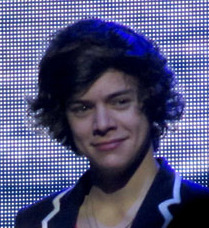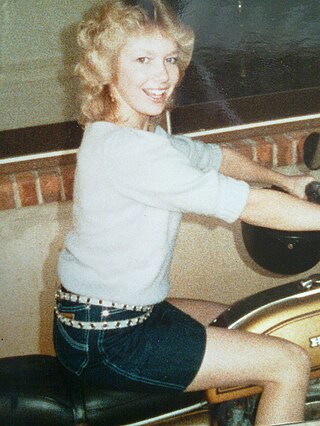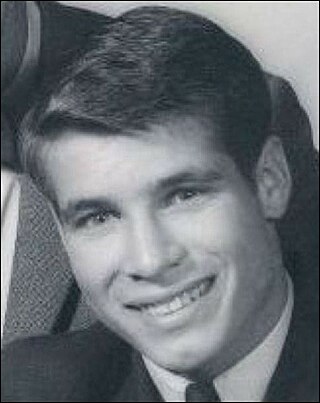
A hairstyle, hairdo, haircut or coiffure refers to the styling of hair, usually on the human head but sometimes on the face or body. The fashioning of hair can be considered an aspect of personal grooming, fashion, and cosmetics, although practical, cultural, and popular considerations also influence some hairstyles.

Butch and femme are masculine (butch) or feminine (femme) identities in the lesbian subculture that have associated traits, behaviors, styles, self-perception, and so on. This concept has been called a "way to organize sexual relationships and gender and sexual identity". Butch–femme culture is not the sole form of a lesbian dyadic system, as there are many women in butch–butch and femme–femme relationships.
Femme is a term traditionally used to describe a lesbian woman who exhibits a feminine identity or gender presentation. While commonly viewed as a lesbian term, alternate meanings of the word also exist with some non-lesbian individuals using the word, notably some gay men and bisexuals. Some non-binary and transgender individuals also identify as lesbians using this term.

"Lipstick lesbian" is slang for a lesbian who exhibits a great amount of feminine gender attributes, such as wearing make-up, dresses or skirts, and having other characteristics associated with feminine women. In popular usage, the term is also used to characterize the feminine gender expression of bisexual women, or the broader topic of female–female sexual activity among feminine women.

A buzz cut, or wiffle cut, is a variety of short hairstyles, especially where the length of hair is the same on all parts of the head. Rising to prominence initially with the advent of manual hair clippers, buzz cuts became increasingly popular in places where strict grooming conventions applied. In several nations, buzz cuts are often given to new recruits in the armed forces or newly incarcerated inmates. However, buzz cuts are also used for stylistic reasons.
LGBT slang, LGBT speak, queer slang, or gay slang is a set of English slang lexicon used predominantly among LGBTQ+ people. It has been used in various languages since the early 20th century as a means by which members of the LGBTQ+ community identify themselves and speak in code with brevity and speed to others. The acronym LGBT was popularized in the 1990s and stands for Lesbian, Gay, Bisexual, and Transgender. It may refer to anyone who is non-heterosexual or non-cisgender, instead of exclusively to people who are lesbian, gay, bisexual, or transgender. To recognize this inclusion, a popular variant, LGBTQ, adds the letter Q for those who identify as queer or are questioning their sexual or gender identity.

The high and tight is a military variant of the crew cut. It is a very short hairstyle, characterized by the back and sides of the head being shaved to the skin and the option for the top to be blended or faded into slightly longer hair. It is most commonly worn by men in the U.S. armed forces. It is also popular with law enforcement officers and other public safety personnel. Although "high and tight" is the primary term used in military and law enforcement, the same haircut is sometimes referred to by civilians as a "walker".

A crew cut is a type of haircut in which the upright hair on the top of the head is cut relatively short, graduated in length from the longest hair that forms a short pomp (pompadour) at the front hairline to the shortest at the back of the crown so that in side profile, the outline of the top hair approaches the horizontal. Relative to the front view, and to varying degrees, the outline of the top hair can be arched or flattened at the short pomp front and rounded or flattened over the rest of the top to complement the front hairline, head shape, face shape and facial features. The hair on the sides and back of the head is usually tapered short, semi-short, or medium.

A flattop is a classic hairstyle characterized by short hair on the sides and back of the head, with the top hair cut short and styled to stand upright in a flat, level plane.
A soft butch, or stem (stud-fem), is a lesbian who exhibits some stereotypical butch traits without fitting the masculine stereotype associated with butch lesbians. Soft butch is on the spectrum of butch, as are stone butch and masculine, whereas on the contrary, ultra fem, high femme, and lipstick lesbian are some labels on the spectrum of lesbians with a more prominent expression of femininity, also known as femmes. Soft butches have gender expressions of women, but primarily display masculine characteristics; soft butches predominantly express masculinity with a touch of femininity.

LGBT stereotypes are stereotypes about lesbian, gay, bisexual and transgender (LGBT) people based on their sexual orientations, gender identities, or gender expressions. Stereotypical perceptions may be acquired through interactions with parents, teachers, peers and mass media, or, more generally, through a lack of firsthand familiarity, resulting in an increased reliance on generalizations.

The wings haircut, also known the Mod haircut, Mop top, flippies, flow, Justin Bieber haircut, or skater hair is a popular hairstyle used in the skateboarding, surfer, mod, and preppy community. Typically long, the style can range from long and drooping below the eyes, to a shorter length. The haircut is typically wavy and, if straight, the length comes to halfway down the ears. Instead of lying on the wearer's ears, the hair flips up and comes straight out like an airplane wing, hence the name. The hairstyle was popular among men in the 1960s, 1970s, mid-late 2000s, early 2010s and 2020s.

The Eton crop is a type of very short, slicked-down crop hairstyle for women.

Short hair refers to any haircut with little length. It may vary from above the ears to below the chin. If a man's hair reaches the chin, it may not be considered short. For a woman, however, short varies from close-cropped to just above the shoulders. This varies from culture to culture, in more traditional societies in Eastern Europe, Asia, and the Islamic world, short hair on women means anything shorter than chest length with chest length to elbow length being considered medium-length. However, among more progressive societies with far less structured gender norms, the classic bob is considered medium-length with "short hair" referring to pixie cuts and similar hairstyles. Different styles of short hair include the bob cut, the crop and the pixie cut.

Hairstyles in the 1980s included the mullet, tall mohawk hairstyles, jheri curls, flattops, and hi-top fades, which became popular styles. Amongst women, large hair-dos, puffed-up styles, permanent waves, and softer cuts typified the decade. Big hair that was "often permed to achieve the desired volume" is especially associated with women of the mid 1980s as well as male rockstars of that era, especially of the glam metal genre. Television shows such as Dynasty helped popularize the high volume bouffant and glamorous image associated with it.

An Ivy League, also known as a Harvard Clip or Princeton, is a type of crew cut in which the hair on the top front of the head is long enough to style with a side part, while the crown of the head is cut short. The length of the top hair and the degree of graduation shorter, from the front hairline back, varies with the shape of the skull, density and coarseness of the hair, and the styling preferences of the individual: side-parted crew cut, standard crew cut, brushed forward, etc.

A regular haircut, in Western fashion, is a men's and boys' hairstyle that has hair long enough to comb on top, a defined or deconstructed side part, and a short, semi-short, medium, long, or extra long back and sides. The style is also known by other names including taper cut, regular taper cut, side-part and standard haircut; as well as short back and sides, business-man cut and professional cut, subject to varying national, regional, and local interpretations of the specific taper for the back and sides.
Gender roles in non-heterosexual communities are a topic of much debate; some people believe traditional, heterosexual gender roles are often erroneously enforced on non-heterosexual relationships by means of heteronormative culture and attitudes towards these non-conformative relationships.

Butch is a lesbian who exhibits a masculine identity or gender presentation.

















